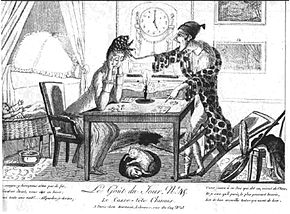- Tangram
-
For other uses, see Tangram (disambiguation).
The tangram (Chinese: 七巧板; pinyin: qī qiǎo bǎn; literally "seven boards of skill") is a dissection puzzle consisting of seven flat shapes, called tans, which are put together to form shapes. The objective of the puzzle is to form a specific shape (given only an outline or silhouette) using all seven pieces, which may not overlap. It was originally invented in China at some unknown point in history, and then carried over to Europe by trading ships in the early 19th century. It became very popular in Europe for a time then, and then again during World War I. It is one of the most popular dissection puzzles in the world.[1][2]
Contents
History
Reaching the Western world (1815–1820s)
 A caricature published in France in 1818, when the Tangram craze was at its peak. The caption reads: " 'Take care of yourself, you're not made of steel. The fire has almost gone out and it is winter.' 'It kept me busy all night. Excuse me, I will explain it to you. You play this game, which is said to hail from China. And I tell you that what Paris needs right now is to welcome that which comes from far away.' "
A caricature published in France in 1818, when the Tangram craze was at its peak. The caption reads: " 'Take care of yourself, you're not made of steel. The fire has almost gone out and it is winter.' 'It kept me busy all night. Excuse me, I will explain it to you. You play this game, which is said to hail from China. And I tell you that what Paris needs right now is to welcome that which comes from far away.' "
The tangram had already been around in China for a long time when it was first brought to America by Captain M. Donnaldson, on his ship, Trader, in 1815. When it docked in Canton, the captain was given a pair of Sang-hsia-k'o's Tangram books from 1815.[3] They were then brought with the ship to Philadelphia, where it docked in February 1816. The first Tangram book to be published in America was based on the pair brought by Donnaldson.
The puzzle was originally popularized by The Eighth Book Of Tan, a fictitious history of Tangram, which claimed that the game was invented 4,000 years prior by a god named Tan. The book included 700 shapes, some of which are impossible to solve.[4]
 Cover art from "The 8th Book of Tan", by Sam Loyd, a spoof of the puzzle's history that began the Tangram Craze in the Western World
Cover art from "The 8th Book of Tan", by Sam Loyd, a spoof of the puzzle's history that began the Tangram Craze in the Western World
The puzzle eventually reached England, where it became very fashionable indeed.[3] The craze quickly spread to other European countries.[3] This was mostly due to a pair of British Tangram books, The Fashionable Chinese Puzzle, and the accompanying solution book, Key.[5] Soon, tangram sets were being exported in great number from China, made of various materials, from glass, to wood, to tortoise shell.[6]
Many of these unusual and exquisite tangram sets made their way to Denmark. Danish interest in tangrams skyrocketed around 1818, when two books on the puzzle were published, to much enthusiasm.[7] The first of these was Mandarinen (About the Chinese Game). This was written by a student at Copenhagen University, which was a non-fictional work about the history and popularity of tangrams. The second, Der nye chinesisre Saadespil (The new Chinese Puzzle Game), consisted of 339 puzzles copied from The 8th Book of Tan, as well as one original.[7]
One contributing factor in the popularity of the game in Europe was that although the Catholic Church forbade many forms of recreation on the sabbath, they made no objection to puzzle games such as the tangram.[8]
The second craze in Germany and America (1891–1920s)
Tangrams were first introduced to the German public by industrialist Friedrich Adolf Richter around 1891.[9] The sets were made out of stone or false earthenware,[10] and marketed under the name "The Anchor Puzzle".[9]
More internationally, the First World War saw a great resurgence of interest in Tangrams, on the homefront and trenches of both sides. During this time, it occasionally went under the name of "The Sphinx", an alternate title for the "Anchor Puzzle" sets.[11][12]
Paradoxes
Loyd's paradox
A tangram paradox is an apparent dissection fallacy: Two figures composed with the same set of pieces, one of which seems to be a proper subset of the other.[13] One famous paradox is that of the two monks, attributed to Dudeney, which consists of two similar shapes, one with and the other missing a foot.[14] Another is proposed by Sam Loyd in The Eighth Book Of Tan:
The seventh and eighth figures represent the mysterious square, built with seven pieces: then with a corner clipped off, and still the same seven pieces employed.[15]Other similar, but possible, apparent paradoxes are in fact fallacious. For example, in the case of the two monks mentioned above, the foot is actually compensated for in the second figure by a subtly larger body.[13]
Number of configurations
Over 6500 different tangram problems have been compiled from 19th century texts alone, and the current number is ever-growing.[16] The number is finite, however. Fu Traing Wang and Chuan-Chin Hsiung proved in 1942 that there are only thirteen convex tangram configurations (configurations such that a line segment drawn between any two points on the configuration's edge always pass through the configuration's interior, i.e., configurations with no recesses in the outline).[17][18]
Pieces
Choosing a unit of measurement so that the seven pieces can be assembled to form a square of side one unit and having area one square unit, the seven pieces are:
- 2 large right triangles (hypotenuse
 , sides
, sides  , area
, area  )
) - 1 medium right triangle (hypotenuse
 , sides
, sides  , area
, area  )
) - 2 small right triangle (hypotenuse
 , sides
, sides  , area
, area  )
) - 1 square (sides
 , area
, area  )
) - 1 parallelogram (sides of
 and
and  , area
, area  )
)
Of these seven pieces, the parallelogram is unique in that it has no reflection symmetry but only rotational symmetry, and so its mirror image can only be obtained by flipping it over. Thus, it is the only piece that may need to be flipped when forming certain shapes.
See also
References
- ^ Slocum, Jerry (2001). The Tao of Tangram. Barnes & Noble. p. 9. ISBN 978-1-4351-0156-2.
- ^ Forbrush, William Byron (1914). Manual of Play. Jacobs. p. 315. http://books.google.com/?id=FpoWAAAAIAAJ&pg=PA315&dq=%22The+Anchor+Puzzle%22#v=onepage&q=%22The%20Anchor%20Puzzle%22&f=false. Retrieved 10/13/10.
- ^ a b c Slocum, Jerry (2003). The Tangram Book. Sterling. p. 30. ISBN 049725504134.
- ^ Costello, Matthew J. (1996). The Greatest Puzzles of All Time. New York: Dover Publications. ISBN 0-486-29225-8.
- ^ Slocum, Jerry (2003). The Tangram Book. Sterling. p. 31. ISBN 049725504134.
- ^ Slocum, Jerry (2003). The Tangram Book. Sterling. p. 49. ISBN 049725504134.
- ^ a b Slocum, Jerry (2003). The Tangram Book. Sterling. pp. 99–100. ISBN 049725504134.
- ^ Slocum, Jerry (2003). The Tangram Book. Sterling. p. 51. ISBN 049725504134.
- ^ a b http://www.archimedes-lab.org/tangramagicus/pagetang1.html
- ^ Treasury Decisions Under customs and other laws, Volume 25. United States Department Of The Treasury. 1890–1926. p. 1421. http://books.google.com/?id=MeUWAQAAIAAJ&pg=PA1421&lpg=PA1421&dq=%22The+Anchor+Puzzle%22#v=onepage&q=%22The%20Anchor%20Puzzle%22&f=false. Retrieved 9/16/10.
- ^ Wyatt (26 April 2006). "Tangram – The Chinese Puzzle". BBC. http://www.bbc.co.uk/dna/h2g2/alabaster/A10423595. Retrieved 3 October 2010.
- ^ Braman, Arlette (2002). Kids Around The World Play!. John Wiley and Sons. p. 10. ISBN 9780471409847. http://books.google.com/?id=fNnoxIfJg5UC&printsec=frontcover&dq=Kids+Around+The+World+Play!&q. Retrieved 9/5/2010.
- ^ a b Tangram Paradox, by Barile, Margherita, From MathWorld – A Wolfram Web Resource, created by Eric W. Weisstein.
- ^ Dudeney, H. (1958). Amusements in Mathematics. New York: Dover Publications.
- ^ Loyd, Sam (1968). The eighth book of Tan – 700 Tangrams by Sam Loyd with an introduction and solutions by Peter Van Note. New York: Dover Publications. p. 25.
- ^ Slocum, Jerry (2001). The Tao of Tangram. Barnes & Noble. p. 37. ISBN 978-1-4351-0156-2.
- ^ Fu Traing Wang; Chuan-Chih Hsiung (November 1942). "A Theorem on the Tangram". The American Mathematical Monthly 49 (9): 596–599. doi:10.2307/2303340. JSTOR 2303340.
- ^ Read, Ronald C. (1965). Tangrams : 330 Puzzles. New York: Dover Publications. p. 53. ISBN 0-486-21483-4.
Further reading
- Anno, Mitsumasa. Anno's Math Games (three volumes). New York: Philomel Books, 1987. ISBN 0399211519 (v. 1), ISBN 0698116720 (v. 2), ISBN 039922274X (v. 3).
- Botermans, Jack, et al. The World of Games: Their Origins and History, How to Play Them, and How to Make Them (translation of Wereld vol spelletjes). New York: Facts on File, 1989. ISBN 0816021848.
- Dudeney, H. E. Amusements in Mathematics. New York: Dover Publications, 1958.
- Gardner, Martin. "Mathematical Games—on the Fanciful History and the Creative Challenges of the Puzzle Game of Tangrams", Scientific American Aug. 1974, p. 98–103.
- Gardner, Martin. "More on Tangrams", Scientific American Sep. 1974, p. 187–191.
- Gardner, Martin. The 2nd Scientific American Book of Mathematical Puzzles and Diversions. New York: Simon & Schuster, 1961. ISBN 0671245597.
- Loyd, Sam. Sam Loyd's Book of Tangram Puzzles (The 8th Book of Tan Part I). Mineola, New York: Dover Publications, 1968.
- Slocum, Jerry, et al. Puzzles of Old and New: How to Make and Solve Them. De Meern, Netherlands: Plenary Publications International (Europe); Amsterdam, Netherlands: ADM International; Seattle: Distributed by University of Washington Press, 1986. ISBN 0295963506.
- Slocum, Jerry, et al. The Tangram Book: The Story of the Chinese Puzzle with Over 2000 Puzzles to Solve. New York: Sterling Publishing Company, 2003. ISBN 1-4027-0413-5.
External links
- "Tangram" by Enrique Zeleny, Wolfram Demonstrations Project
- "New Tangram paradoxes" by Gianni A. Sarcone, Archimedes Laboratory Project
[]]
Categories:- Tiling puzzles
- Chinese games
- Recreational mathematics
- 2 large right triangles (hypotenuse
Wikimedia Foundation. 2010.


